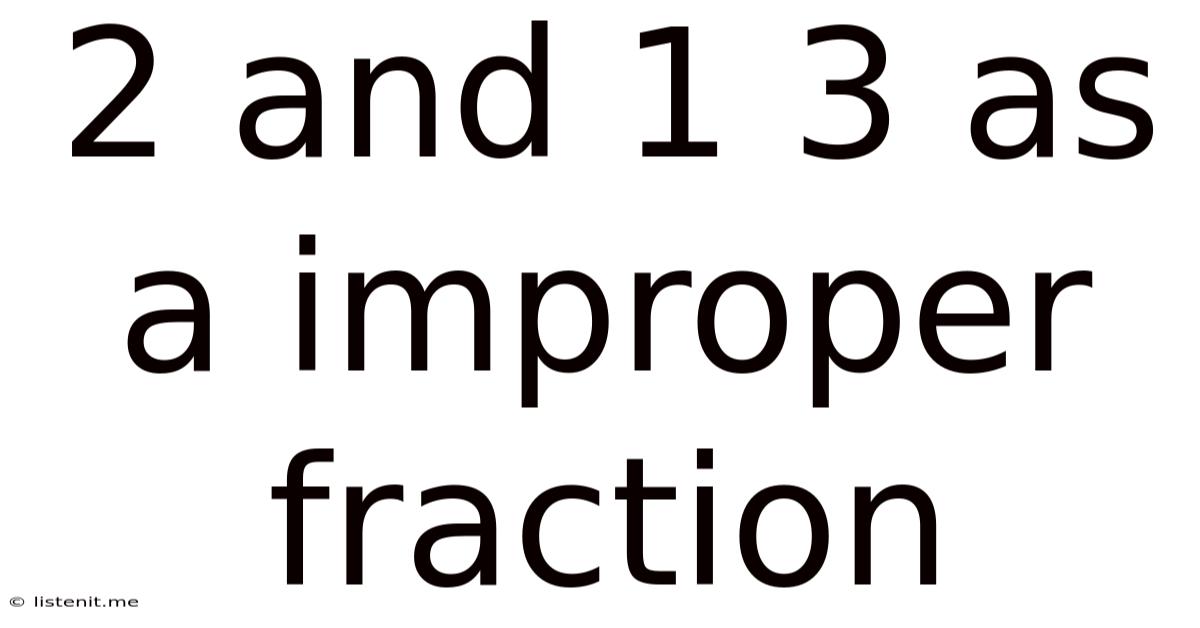2 And 1 3 As A Improper Fraction
listenit
May 11, 2025 · 4 min read

Table of Contents
2 and 1/3 as an Improper Fraction: A Comprehensive Guide
Understanding fractions is fundamental to mathematics, and converting mixed numbers (like 2 and 1/3) into improper fractions is a crucial skill. This comprehensive guide will walk you through the process, explore the concept in depth, and provide you with plenty of examples and practice problems. We'll also touch upon the practical applications of this conversion in everyday life and more advanced mathematical contexts.
What are Mixed Numbers and Improper Fractions?
Before diving into the conversion process, let's define our key terms:
Mixed Number: A mixed number combines a whole number and a proper fraction. A proper fraction is a fraction where the numerator (the top number) is smaller than the denominator (the bottom number). For example, 2 and 1/3 is a mixed number because it combines the whole number 2 with the proper fraction 1/3.
Improper Fraction: An improper fraction is a fraction where the numerator is greater than or equal to the denominator. For example, 7/3 is an improper fraction because the numerator (7) is larger than the denominator (3).
Converting 2 and 1/3 to an Improper Fraction
The conversion process is straightforward and involves two simple steps:
Step 1: Multiply the whole number by the denominator.
In our example, 2 and 1/3, the whole number is 2, and the denominator of the fraction is 3. Therefore, we multiply 2 * 3 = 6.
Step 2: Add the result to the numerator.
The result from Step 1 (6) is added to the numerator of the fraction (1). This gives us 6 + 1 = 7.
Step 3: Keep the same denominator.
The denominator remains unchanged. In this case, the denominator stays as 3.
Therefore, 2 and 1/3 as an improper fraction is 7/3.
Visualizing the Conversion
Imagine you have two whole pizzas and one-third of a pizza. To represent this as an improper fraction, we need to consider how many slices of pizza you have in total, assuming each pizza is cut into 3 equal slices.
- Two whole pizzas would give you 2 * 3 = 6 slices.
- Adding the extra one-third of a pizza gives you 6 + 1 = 7 slices.
- Since each pizza was cut into 3 slices, the denominator remains 3.
This visualization confirms that 2 and 1/3 is equivalent to 7/3.
Why is this Conversion Important?
Converting mixed numbers to improper fractions is crucial for several reasons:
-
Simplifying Calculations: Improper fractions are often easier to work with when performing multiplication and division of fractions. Trying to multiply mixed numbers directly can be more complex.
-
Solving Equations: Many mathematical equations require fractions to be in improper form to find solutions effectively.
-
Working with Ratios and Proportions: Converting to improper fractions is essential when dealing with ratios and proportions where a common denominator is needed.
-
Understanding Complex Fractions: Converting to improper fractions is a stepping stone to mastering complex fractions (fractions within fractions).
-
Real-World Applications: Imagine baking a recipe that requires 2 and 1/3 cups of flour. Knowing how to convert this to 7/3 cups makes measuring and calculating more efficient.
Practice Problems
Let's test your understanding with some practice problems. Convert the following mixed numbers to improper fractions:
- 3 and 1/2
- 1 and 2/5
- 5 and 3/4
- 2 and 5/8
- 10 and 2/3
Solutions:
- 7/2
- 7/5
- 23/4
- 21/8
- 32/3
Converting Improper Fractions to Mixed Numbers
The reverse process is also important. Let's learn how to convert an improper fraction back into a mixed number using 7/3 as an example:
Step 1: Divide the numerator by the denominator.
Divide 7 by 3. This gives you 2 with a remainder of 1.
Step 2: The quotient becomes the whole number.
The quotient (2) becomes the whole number part of the mixed number.
Step 3: The remainder becomes the numerator of the fraction.
The remainder (1) becomes the numerator of the fraction.
Step 4: The denominator stays the same.
The denominator (3) remains unchanged.
Therefore, 7/3 is equal to 2 and 1/3.
Advanced Applications
The concept of converting between mixed numbers and improper fractions extends to more advanced mathematical concepts, including:
-
Algebra: Solving algebraic equations often involves manipulating fractions, and the ability to convert between mixed numbers and improper fractions is crucial for simplification and solution.
-
Calculus: Derivatives and integrals frequently involve fractional expressions, making this conversion a vital skill for calculus students.
-
Engineering and Physics: Many engineering and physics calculations rely heavily on fractions, making the ability to work with both mixed numbers and improper fractions indispensable.
Conclusion
Converting mixed numbers to improper fractions is a fundamental skill in mathematics with wide-ranging applications. By mastering this process and understanding its underlying principles, you'll enhance your mathematical abilities and tackle more complex problems with confidence. This skill isn't just confined to textbooks; it's a practical tool applicable to everyday life, from baking to advanced scientific calculations. Regular practice will solidify your understanding and make this conversion a second nature. Remember to visualize the process to better grasp the concepts. Now, go forth and conquer those fractions!
Latest Posts
Latest Posts
-
A Chemical Combination Of Two Or More Elements
May 12, 2025
-
What Distinguishes A Neutral Atom From An Ion
May 12, 2025
-
7 Protons 8 Neutrons 7 Electrons
May 12, 2025
-
What Does Light Travel Fastest Through Solid Liquid Or Gas
May 12, 2025
-
A Major Function Of The Cell Membrane Is To
May 12, 2025
Related Post
Thank you for visiting our website which covers about 2 And 1 3 As A Improper Fraction . We hope the information provided has been useful to you. Feel free to contact us if you have any questions or need further assistance. See you next time and don't miss to bookmark.